Economics for Managers: Analysis of Road Congestion and Pricing
VerifiedAdded on 2021/02/20
|11
|3356
|105
Report
AI Summary
This report, focusing on economics for managers, analyzes road congestion in Australia and globally, examines market prices, demand, and supply of road space, and explores road pricing systems. It begins with an introduction to economics for managers and summarizes an article on road congestion in Australia. The report then delves into the concept of competitive equilibrium, excess demand for road space, and the impact of congestion. It also discusses road pricing systems, their pros and cons, and provides examples of cities facing congestion problems, such as London. The report uses economic theories such as public good theory and sustainable development to analyze the issues and proposes potential solutions for reducing congestion. The document is a student assignment available on Desklib, a platform providing AI-based study tools.
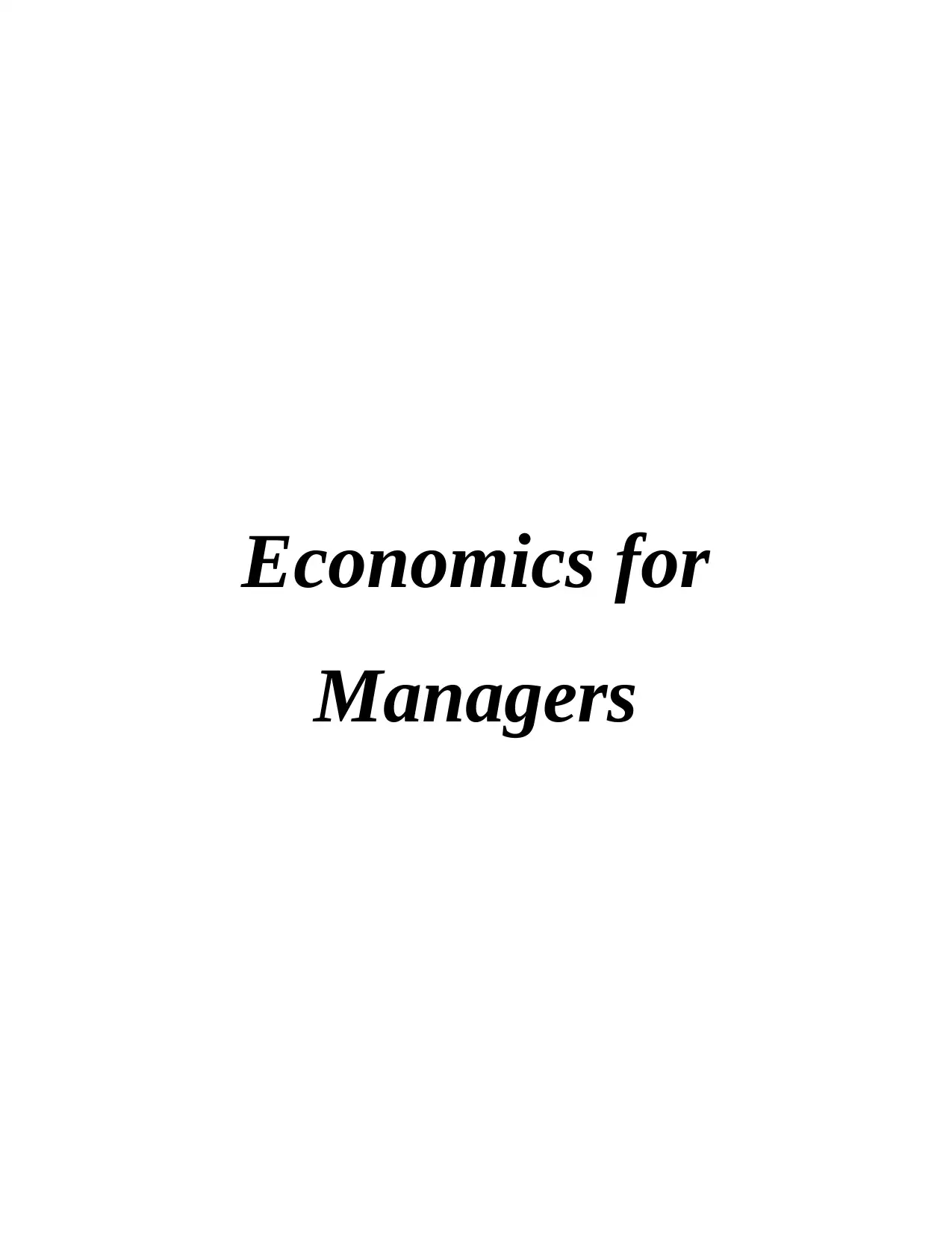
Economics for
Managers
Managers
Paraphrase This Document
Need a fresh take? Get an instant paraphrase of this document with our AI Paraphraser
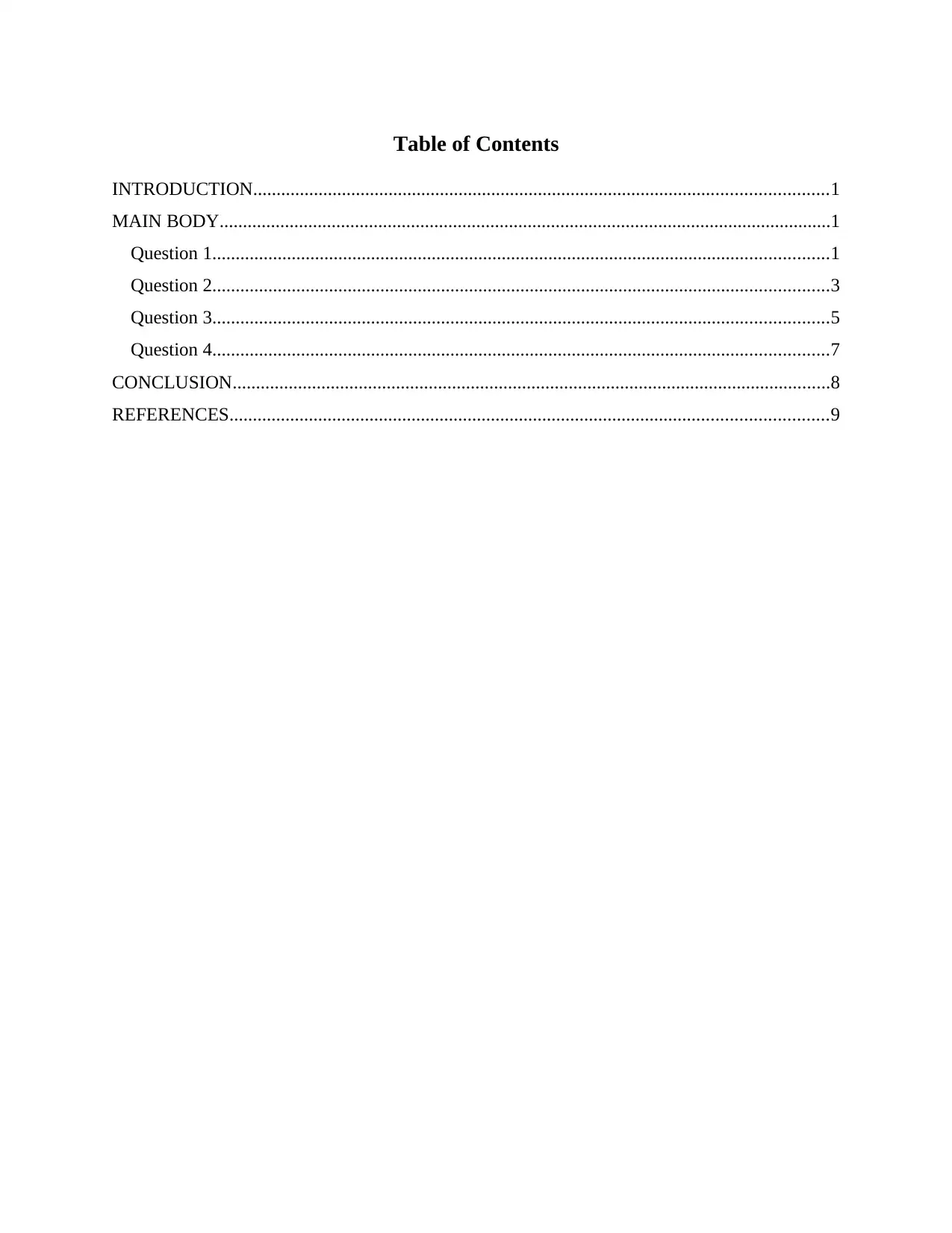
Table of Contents
INTRODUCTION...........................................................................................................................1
MAIN BODY...................................................................................................................................1
Question 1....................................................................................................................................1
Question 2....................................................................................................................................3
Question 3....................................................................................................................................5
Question 4....................................................................................................................................7
CONCLUSION................................................................................................................................8
REFERENCES................................................................................................................................9
INTRODUCTION...........................................................................................................................1
MAIN BODY...................................................................................................................................1
Question 1....................................................................................................................................1
Question 2....................................................................................................................................3
Question 3....................................................................................................................................5
Question 4....................................................................................................................................7
CONCLUSION................................................................................................................................8
REFERENCES................................................................................................................................9
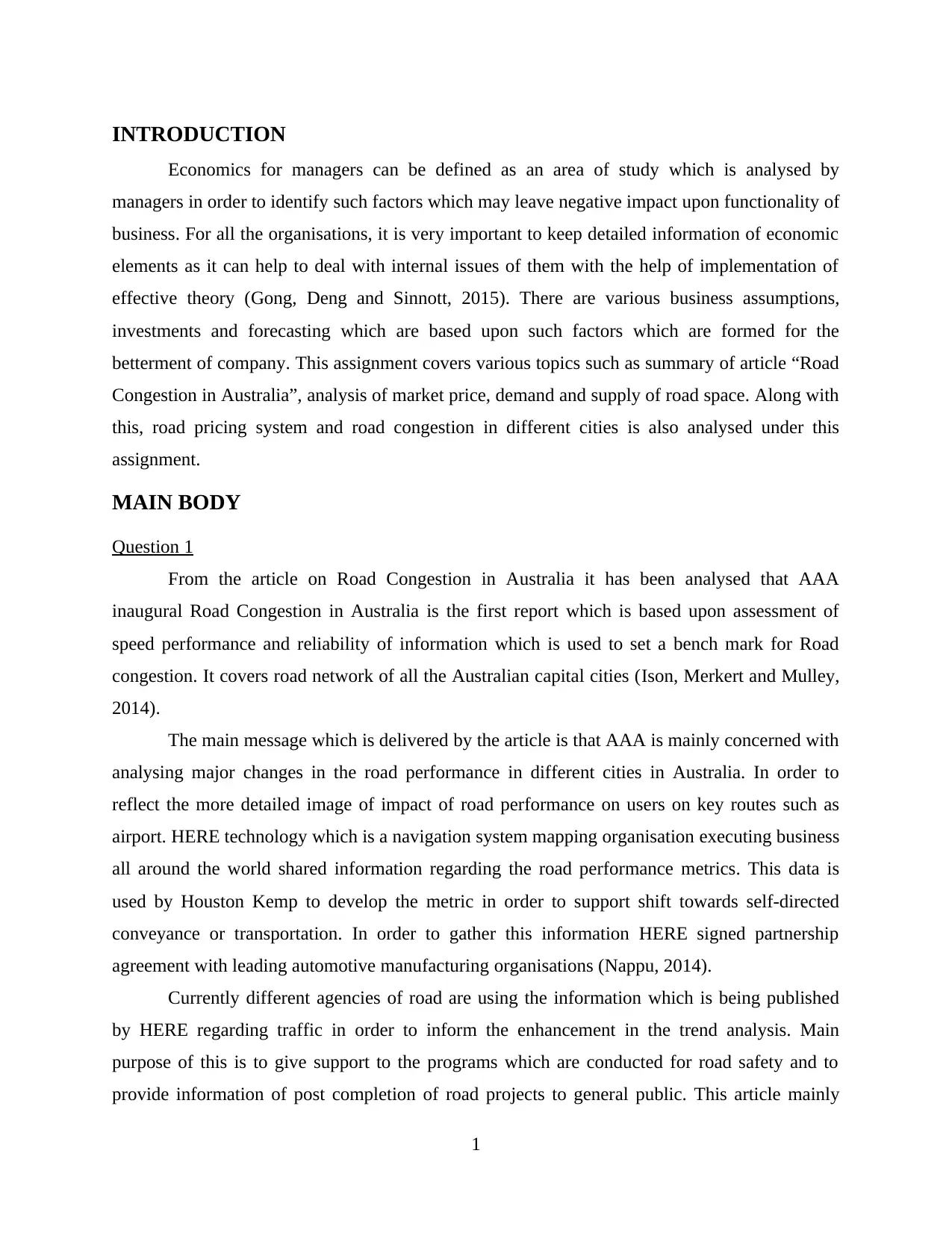
INTRODUCTION
Economics for managers can be defined as an area of study which is analysed by
managers in order to identify such factors which may leave negative impact upon functionality of
business. For all the organisations, it is very important to keep detailed information of economic
elements as it can help to deal with internal issues of them with the help of implementation of
effective theory (Gong, Deng and Sinnott, 2015). There are various business assumptions,
investments and forecasting which are based upon such factors which are formed for the
betterment of company. This assignment covers various topics such as summary of article “Road
Congestion in Australia”, analysis of market price, demand and supply of road space. Along with
this, road pricing system and road congestion in different cities is also analysed under this
assignment.
MAIN BODY
Question 1
From the article on Road Congestion in Australia it has been analysed that AAA
inaugural Road Congestion in Australia is the first report which is based upon assessment of
speed performance and reliability of information which is used to set a bench mark for Road
congestion. It covers road network of all the Australian capital cities (Ison, Merkert and Mulley,
2014).
The main message which is delivered by the article is that AAA is mainly concerned with
analysing major changes in the road performance in different cities in Australia. In order to
reflect the more detailed image of impact of road performance on users on key routes such as
airport. HERE technology which is a navigation system mapping organisation executing business
all around the world shared information regarding the road performance metrics. This data is
used by Houston Kemp to develop the metric in order to support shift towards self-directed
conveyance or transportation. In order to gather this information HERE signed partnership
agreement with leading automotive manufacturing organisations (Nappu, 2014).
Currently different agencies of road are using the information which is being published
by HERE regarding traffic in order to inform the enhancement in the trend analysis. Main
purpose of this is to give support to the programs which are conducted for road safety and to
provide information of post completion of road projects to general public. This article mainly
1
Economics for managers can be defined as an area of study which is analysed by
managers in order to identify such factors which may leave negative impact upon functionality of
business. For all the organisations, it is very important to keep detailed information of economic
elements as it can help to deal with internal issues of them with the help of implementation of
effective theory (Gong, Deng and Sinnott, 2015). There are various business assumptions,
investments and forecasting which are based upon such factors which are formed for the
betterment of company. This assignment covers various topics such as summary of article “Road
Congestion in Australia”, analysis of market price, demand and supply of road space. Along with
this, road pricing system and road congestion in different cities is also analysed under this
assignment.
MAIN BODY
Question 1
From the article on Road Congestion in Australia it has been analysed that AAA
inaugural Road Congestion in Australia is the first report which is based upon assessment of
speed performance and reliability of information which is used to set a bench mark for Road
congestion. It covers road network of all the Australian capital cities (Ison, Merkert and Mulley,
2014).
The main message which is delivered by the article is that AAA is mainly concerned with
analysing major changes in the road performance in different cities in Australia. In order to
reflect the more detailed image of impact of road performance on users on key routes such as
airport. HERE technology which is a navigation system mapping organisation executing business
all around the world shared information regarding the road performance metrics. This data is
used by Houston Kemp to develop the metric in order to support shift towards self-directed
conveyance or transportation. In order to gather this information HERE signed partnership
agreement with leading automotive manufacturing organisations (Nappu, 2014).
Currently different agencies of road are using the information which is being published
by HERE regarding traffic in order to inform the enhancement in the trend analysis. Main
purpose of this is to give support to the programs which are conducted for road safety and to
provide information of post completion of road projects to general public. This article mainly
1
⊘ This is a preview!⊘
Do you want full access?
Subscribe today to unlock all pages.

Trusted by 1+ million students worldwide
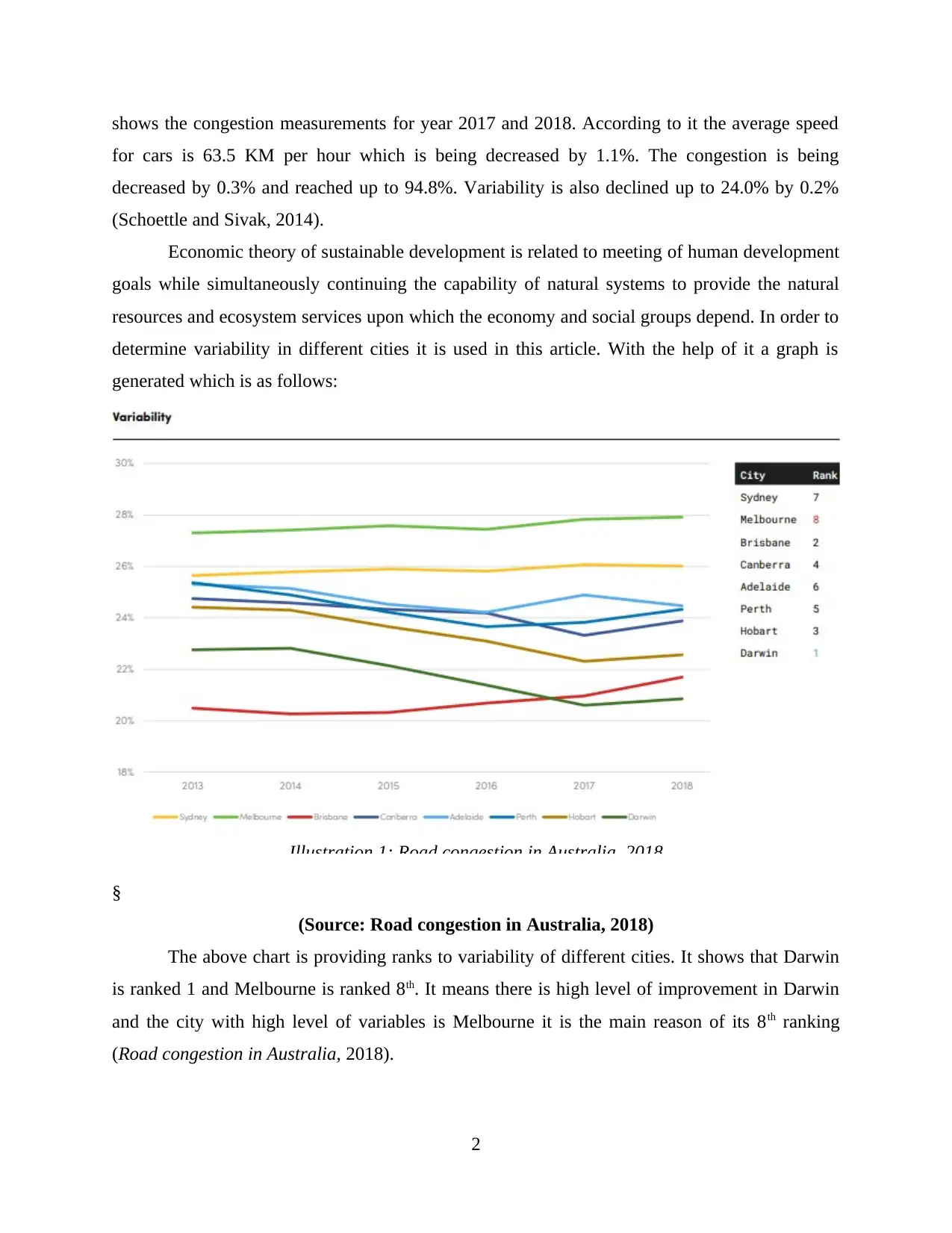
shows the congestion measurements for year 2017 and 2018. According to it the average speed
for cars is 63.5 KM per hour which is being decreased by 1.1%. The congestion is being
decreased by 0.3% and reached up to 94.8%. Variability is also declined up to 24.0% by 0.2%
(Schoettle and Sivak, 2014).
Economic theory of sustainable development is related to meeting of human development
goals while simultaneously continuing the capability of natural systems to provide the natural
resources and ecosystem services upon which the economy and social groups depend. In order to
determine variability in different cities it is used in this article. With the help of it a graph is
generated which is as follows:
Illustration 1: Road congestion in Australia, 2018
§
(Source: Road congestion in Australia, 2018)
The above chart is providing ranks to variability of different cities. It shows that Darwin
is ranked 1 and Melbourne is ranked 8th. It means there is high level of improvement in Darwin
and the city with high level of variables is Melbourne it is the main reason of its 8th ranking
(Road congestion in Australia, 2018).
2
for cars is 63.5 KM per hour which is being decreased by 1.1%. The congestion is being
decreased by 0.3% and reached up to 94.8%. Variability is also declined up to 24.0% by 0.2%
(Schoettle and Sivak, 2014).
Economic theory of sustainable development is related to meeting of human development
goals while simultaneously continuing the capability of natural systems to provide the natural
resources and ecosystem services upon which the economy and social groups depend. In order to
determine variability in different cities it is used in this article. With the help of it a graph is
generated which is as follows:
Illustration 1: Road congestion in Australia, 2018
§
(Source: Road congestion in Australia, 2018)
The above chart is providing ranks to variability of different cities. It shows that Darwin
is ranked 1 and Melbourne is ranked 8th. It means there is high level of improvement in Darwin
and the city with high level of variables is Melbourne it is the main reason of its 8th ranking
(Road congestion in Australia, 2018).
2
Paraphrase This Document
Need a fresh take? Get an instant paraphrase of this document with our AI Paraphraser
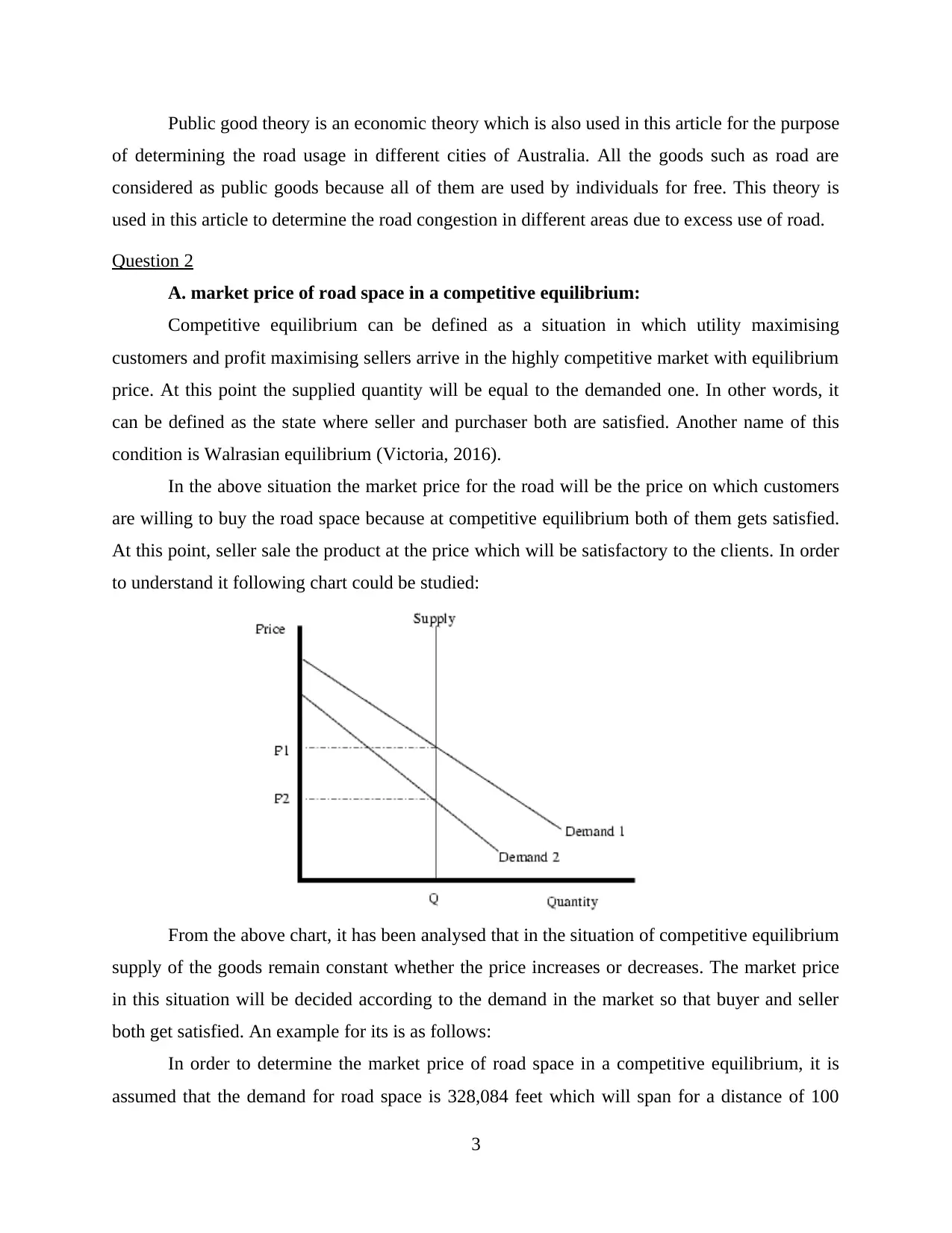
Public good theory is an economic theory which is also used in this article for the purpose
of determining the road usage in different cities of Australia. All the goods such as road are
considered as public goods because all of them are used by individuals for free. This theory is
used in this article to determine the road congestion in different areas due to excess use of road.
Question 2
A. market price of road space in a competitive equilibrium:
Competitive equilibrium can be defined as a situation in which utility maximising
customers and profit maximising sellers arrive in the highly competitive market with equilibrium
price. At this point the supplied quantity will be equal to the demanded one. In other words, it
can be defined as the state where seller and purchaser both are satisfied. Another name of this
condition is Walrasian equilibrium (Victoria, 2016).
In the above situation the market price for the road will be the price on which customers
are willing to buy the road space because at competitive equilibrium both of them gets satisfied.
At this point, seller sale the product at the price which will be satisfactory to the clients. In order
to understand it following chart could be studied:
From the above chart, it has been analysed that in the situation of competitive equilibrium
supply of the goods remain constant whether the price increases or decreases. The market price
in this situation will be decided according to the demand in the market so that buyer and seller
both get satisfied. An example for its is as follows:
In order to determine the market price of road space in a competitive equilibrium, it is
assumed that the demand for road space is 328,084 feet which will span for a distance of 100
3
of determining the road usage in different cities of Australia. All the goods such as road are
considered as public goods because all of them are used by individuals for free. This theory is
used in this article to determine the road congestion in different areas due to excess use of road.
Question 2
A. market price of road space in a competitive equilibrium:
Competitive equilibrium can be defined as a situation in which utility maximising
customers and profit maximising sellers arrive in the highly competitive market with equilibrium
price. At this point the supplied quantity will be equal to the demanded one. In other words, it
can be defined as the state where seller and purchaser both are satisfied. Another name of this
condition is Walrasian equilibrium (Victoria, 2016).
In the above situation the market price for the road will be the price on which customers
are willing to buy the road space because at competitive equilibrium both of them gets satisfied.
At this point, seller sale the product at the price which will be satisfactory to the clients. In order
to understand it following chart could be studied:
From the above chart, it has been analysed that in the situation of competitive equilibrium
supply of the goods remain constant whether the price increases or decreases. The market price
in this situation will be decided according to the demand in the market so that buyer and seller
both get satisfied. An example for its is as follows:
In order to determine the market price of road space in a competitive equilibrium, it is
assumed that the demand for road space is 328,084 feet which will span for a distance of 100
3
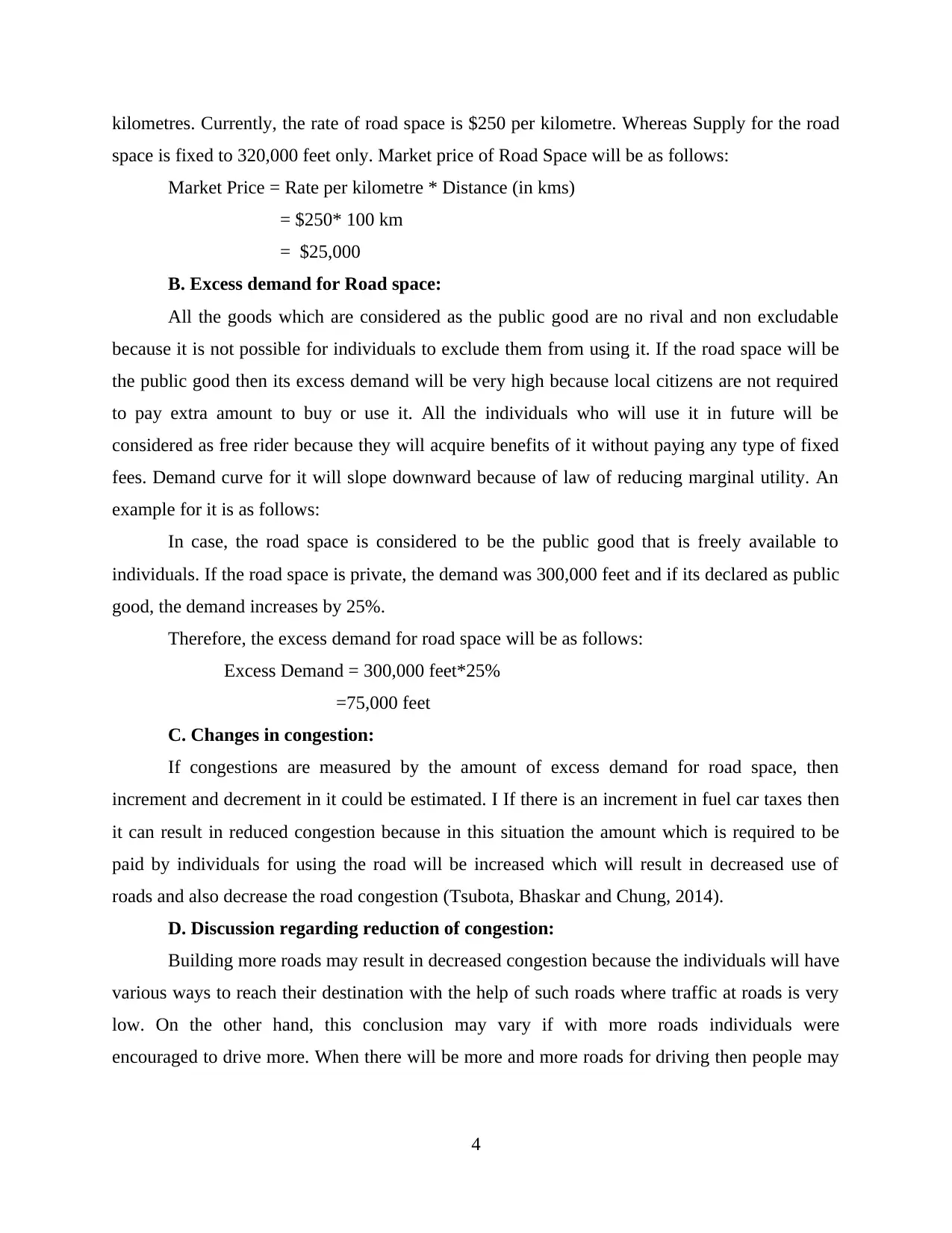
kilometres. Currently, the rate of road space is $250 per kilometre. Whereas Supply for the road
space is fixed to 320,000 feet only. Market price of Road Space will be as follows:
Market Price = Rate per kilometre * Distance (in kms)
= $250* 100 km
= $25,000
B. Excess demand for Road space:
All the goods which are considered as the public good are no rival and non excludable
because it is not possible for individuals to exclude them from using it. If the road space will be
the public good then its excess demand will be very high because local citizens are not required
to pay extra amount to buy or use it. All the individuals who will use it in future will be
considered as free rider because they will acquire benefits of it without paying any type of fixed
fees. Demand curve for it will slope downward because of law of reducing marginal utility. An
example for it is as follows:
In case, the road space is considered to be the public good that is freely available to
individuals. If the road space is private, the demand was 300,000 feet and if its declared as public
good, the demand increases by 25%.
Therefore, the excess demand for road space will be as follows:
Excess Demand = 300,000 feet*25%
=75,000 feet
C. Changes in congestion:
If congestions are measured by the amount of excess demand for road space, then
increment and decrement in it could be estimated. I If there is an increment in fuel car taxes then
it can result in reduced congestion because in this situation the amount which is required to be
paid by individuals for using the road will be increased which will result in decreased use of
roads and also decrease the road congestion (Tsubota, Bhaskar and Chung, 2014).
D. Discussion regarding reduction of congestion:
Building more roads may result in decreased congestion because the individuals will have
various ways to reach their destination with the help of such roads where traffic at roads is very
low. On the other hand, this conclusion may vary if with more roads individuals were
encouraged to drive more. When there will be more and more roads for driving then people may
4
space is fixed to 320,000 feet only. Market price of Road Space will be as follows:
Market Price = Rate per kilometre * Distance (in kms)
= $250* 100 km
= $25,000
B. Excess demand for Road space:
All the goods which are considered as the public good are no rival and non excludable
because it is not possible for individuals to exclude them from using it. If the road space will be
the public good then its excess demand will be very high because local citizens are not required
to pay extra amount to buy or use it. All the individuals who will use it in future will be
considered as free rider because they will acquire benefits of it without paying any type of fixed
fees. Demand curve for it will slope downward because of law of reducing marginal utility. An
example for it is as follows:
In case, the road space is considered to be the public good that is freely available to
individuals. If the road space is private, the demand was 300,000 feet and if its declared as public
good, the demand increases by 25%.
Therefore, the excess demand for road space will be as follows:
Excess Demand = 300,000 feet*25%
=75,000 feet
C. Changes in congestion:
If congestions are measured by the amount of excess demand for road space, then
increment and decrement in it could be estimated. I If there is an increment in fuel car taxes then
it can result in reduced congestion because in this situation the amount which is required to be
paid by individuals for using the road will be increased which will result in decreased use of
roads and also decrease the road congestion (Tsubota, Bhaskar and Chung, 2014).
D. Discussion regarding reduction of congestion:
Building more roads may result in decreased congestion because the individuals will have
various ways to reach their destination with the help of such roads where traffic at roads is very
low. On the other hand, this conclusion may vary if with more roads individuals were
encouraged to drive more. When there will be more and more roads for driving then people may
4
⊘ This is a preview!⊘
Do you want full access?
Subscribe today to unlock all pages.

Trusted by 1+ million students worldwide
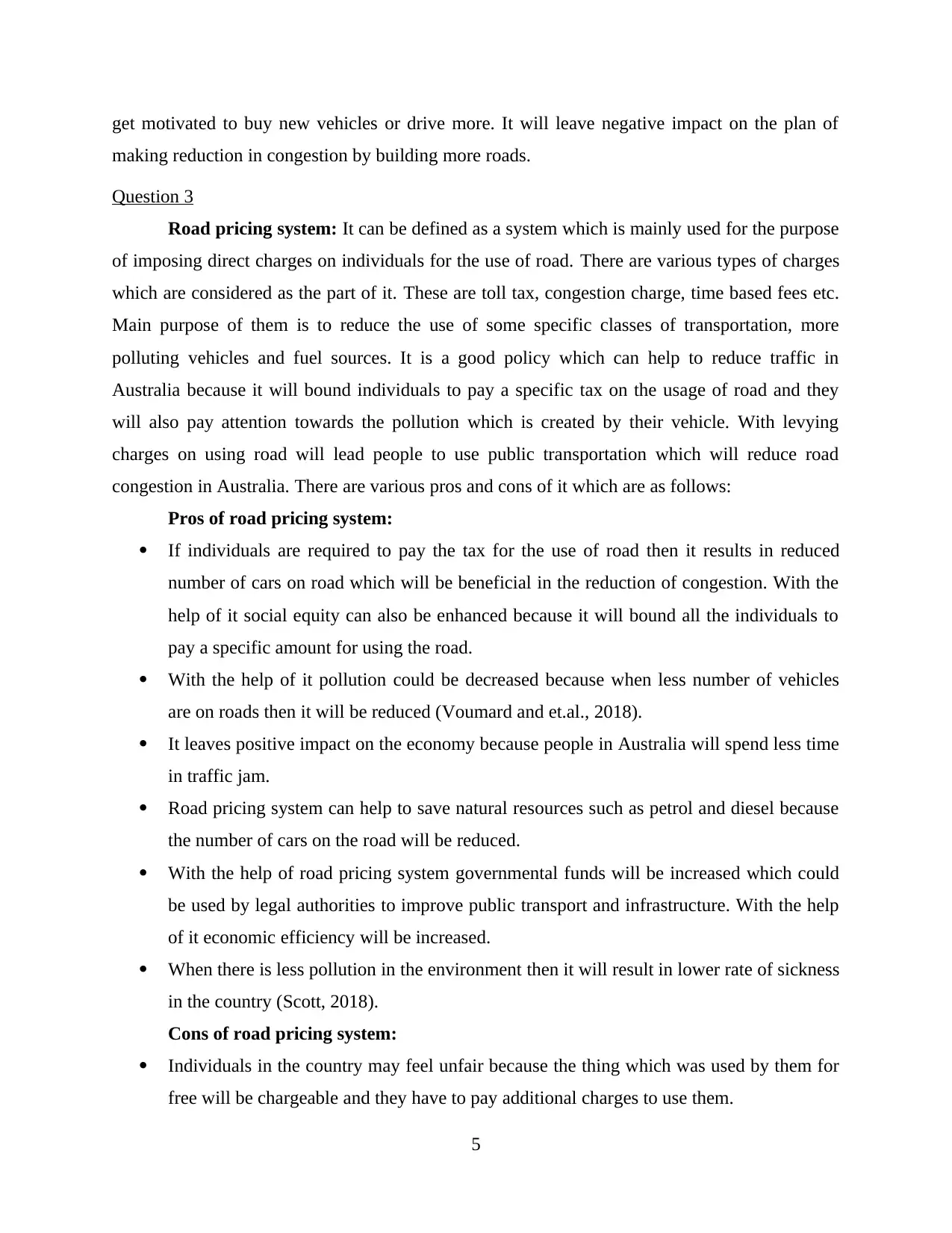
get motivated to buy new vehicles or drive more. It will leave negative impact on the plan of
making reduction in congestion by building more roads.
Question 3
Road pricing system: It can be defined as a system which is mainly used for the purpose
of imposing direct charges on individuals for the use of road. There are various types of charges
which are considered as the part of it. These are toll tax, congestion charge, time based fees etc.
Main purpose of them is to reduce the use of some specific classes of transportation, more
polluting vehicles and fuel sources. It is a good policy which can help to reduce traffic in
Australia because it will bound individuals to pay a specific tax on the usage of road and they
will also pay attention towards the pollution which is created by their vehicle. With levying
charges on using road will lead people to use public transportation which will reduce road
congestion in Australia. There are various pros and cons of it which are as follows:
Pros of road pricing system:
If individuals are required to pay the tax for the use of road then it results in reduced
number of cars on road which will be beneficial in the reduction of congestion. With the
help of it social equity can also be enhanced because it will bound all the individuals to
pay a specific amount for using the road.
With the help of it pollution could be decreased because when less number of vehicles
are on roads then it will be reduced (Voumard and et.al., 2018).
It leaves positive impact on the economy because people in Australia will spend less time
in traffic jam.
Road pricing system can help to save natural resources such as petrol and diesel because
the number of cars on the road will be reduced.
With the help of road pricing system governmental funds will be increased which could
be used by legal authorities to improve public transport and infrastructure. With the help
of it economic efficiency will be increased.
When there is less pollution in the environment then it will result in lower rate of sickness
in the country (Scott, 2018).
Cons of road pricing system:
Individuals in the country may feel unfair because the thing which was used by them for
free will be chargeable and they have to pay additional charges to use them.
5
making reduction in congestion by building more roads.
Question 3
Road pricing system: It can be defined as a system which is mainly used for the purpose
of imposing direct charges on individuals for the use of road. There are various types of charges
which are considered as the part of it. These are toll tax, congestion charge, time based fees etc.
Main purpose of them is to reduce the use of some specific classes of transportation, more
polluting vehicles and fuel sources. It is a good policy which can help to reduce traffic in
Australia because it will bound individuals to pay a specific tax on the usage of road and they
will also pay attention towards the pollution which is created by their vehicle. With levying
charges on using road will lead people to use public transportation which will reduce road
congestion in Australia. There are various pros and cons of it which are as follows:
Pros of road pricing system:
If individuals are required to pay the tax for the use of road then it results in reduced
number of cars on road which will be beneficial in the reduction of congestion. With the
help of it social equity can also be enhanced because it will bound all the individuals to
pay a specific amount for using the road.
With the help of it pollution could be decreased because when less number of vehicles
are on roads then it will be reduced (Voumard and et.al., 2018).
It leaves positive impact on the economy because people in Australia will spend less time
in traffic jam.
Road pricing system can help to save natural resources such as petrol and diesel because
the number of cars on the road will be reduced.
With the help of road pricing system governmental funds will be increased which could
be used by legal authorities to improve public transport and infrastructure. With the help
of it economic efficiency will be increased.
When there is less pollution in the environment then it will result in lower rate of sickness
in the country (Scott, 2018).
Cons of road pricing system:
Individuals in the country may feel unfair because the thing which was used by them for
free will be chargeable and they have to pay additional charges to use them.
5
Paraphrase This Document
Need a fresh take? Get an instant paraphrase of this document with our AI Paraphraser
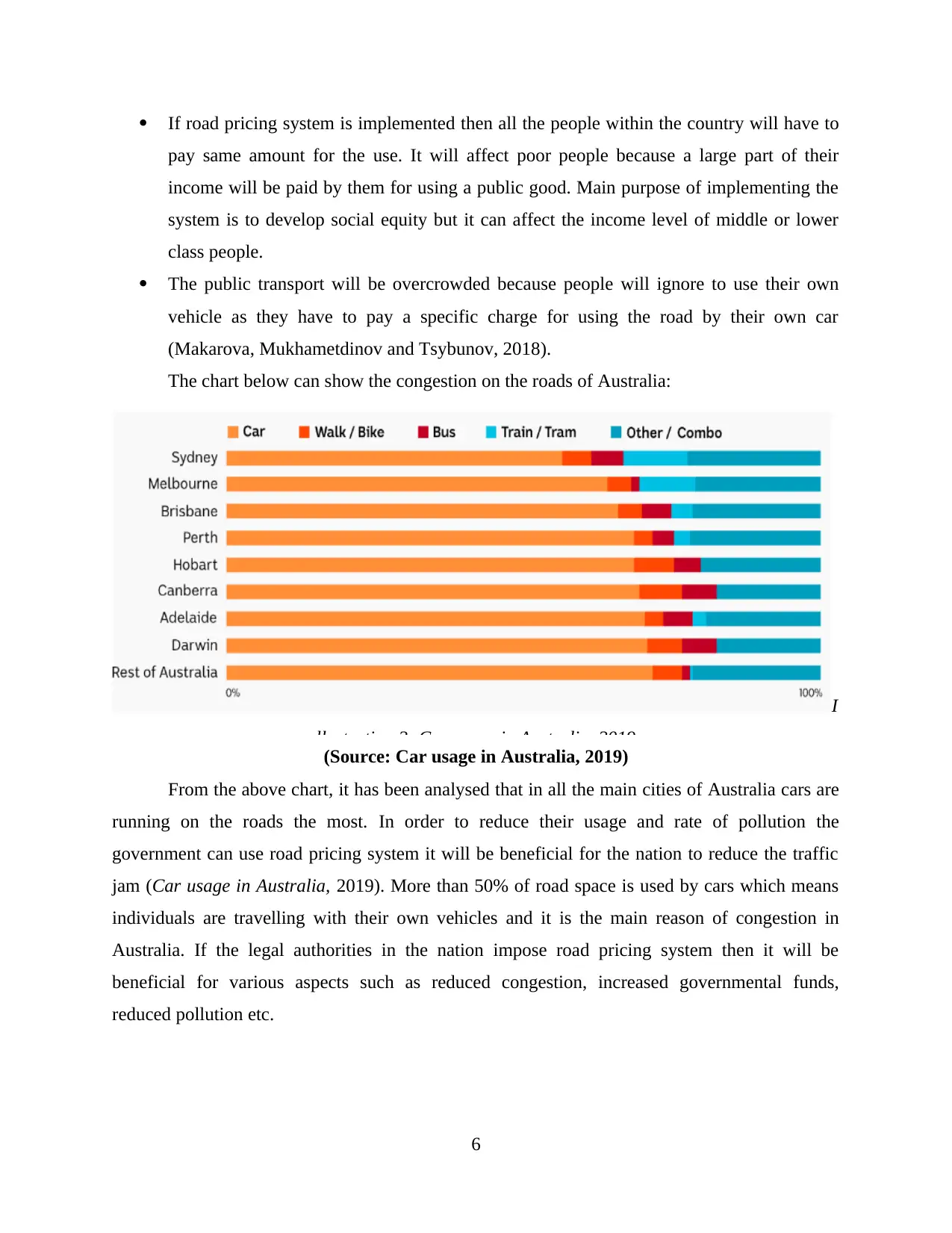
If road pricing system is implemented then all the people within the country will have to
pay same amount for the use. It will affect poor people because a large part of their
income will be paid by them for using a public good. Main purpose of implementing the
system is to develop social equity but it can affect the income level of middle or lower
class people.
The public transport will be overcrowded because people will ignore to use their own
vehicle as they have to pay a specific charge for using the road by their own car
(Makarova, Mukhametdinov and Tsybunov, 2018).
The chart below can show the congestion on the roads of Australia:
I
llustration 2: Car usage in Australia, 2019
(Source: Car usage in Australia, 2019)
From the above chart, it has been analysed that in all the main cities of Australia cars are
running on the roads the most. In order to reduce their usage and rate of pollution the
government can use road pricing system it will be beneficial for the nation to reduce the traffic
jam (Car usage in Australia, 2019). More than 50% of road space is used by cars which means
individuals are travelling with their own vehicles and it is the main reason of congestion in
Australia. If the legal authorities in the nation impose road pricing system then it will be
beneficial for various aspects such as reduced congestion, increased governmental funds,
reduced pollution etc.
6
pay same amount for the use. It will affect poor people because a large part of their
income will be paid by them for using a public good. Main purpose of implementing the
system is to develop social equity but it can affect the income level of middle or lower
class people.
The public transport will be overcrowded because people will ignore to use their own
vehicle as they have to pay a specific charge for using the road by their own car
(Makarova, Mukhametdinov and Tsybunov, 2018).
The chart below can show the congestion on the roads of Australia:
I
llustration 2: Car usage in Australia, 2019
(Source: Car usage in Australia, 2019)
From the above chart, it has been analysed that in all the main cities of Australia cars are
running on the roads the most. In order to reduce their usage and rate of pollution the
government can use road pricing system it will be beneficial for the nation to reduce the traffic
jam (Car usage in Australia, 2019). More than 50% of road space is used by cars which means
individuals are travelling with their own vehicles and it is the main reason of congestion in
Australia. If the legal authorities in the nation impose road pricing system then it will be
beneficial for various aspects such as reduced congestion, increased governmental funds,
reduced pollution etc.
6
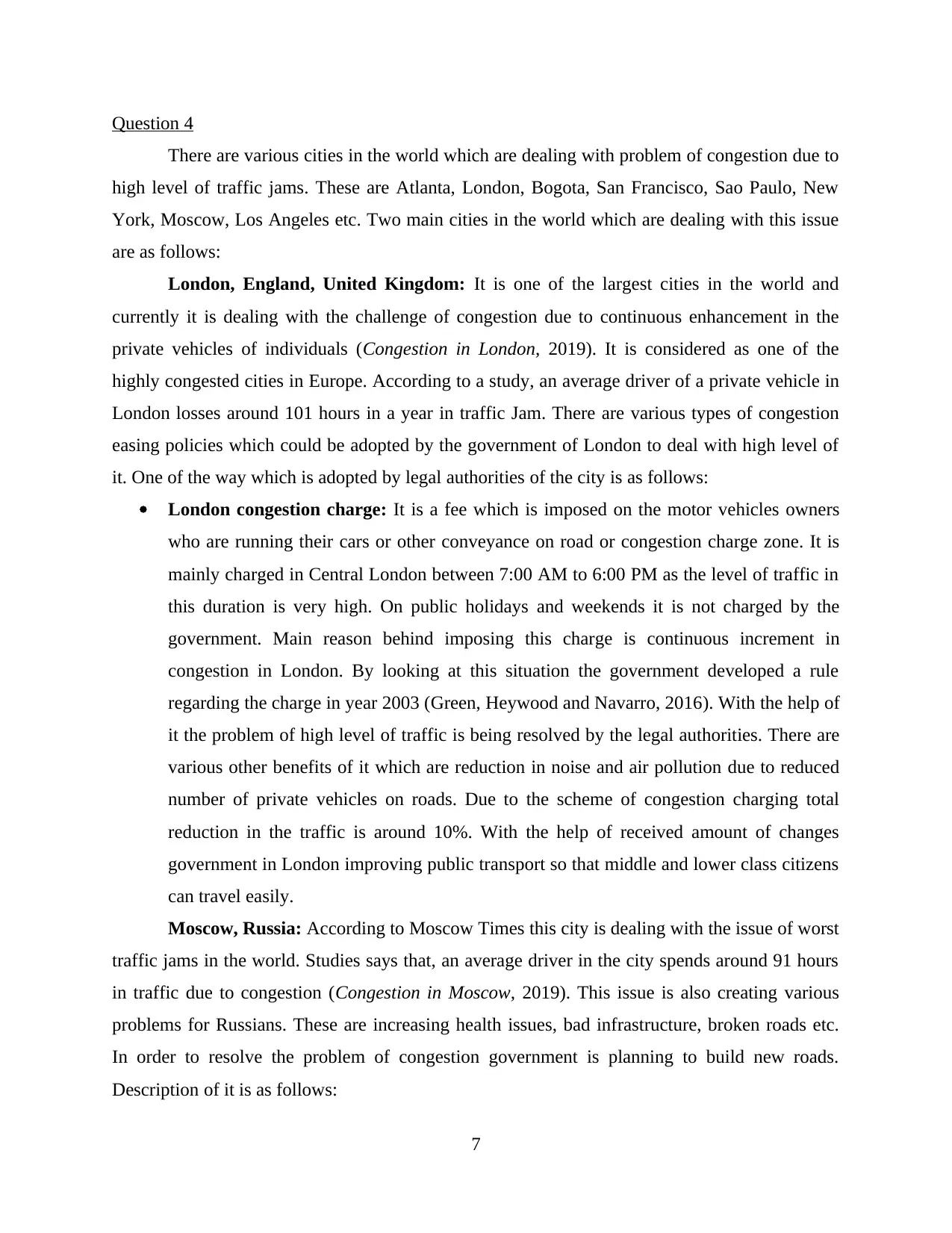
Question 4
There are various cities in the world which are dealing with problem of congestion due to
high level of traffic jams. These are Atlanta, London, Bogota, San Francisco, Sao Paulo, New
York, Moscow, Los Angeles etc. Two main cities in the world which are dealing with this issue
are as follows:
London, England, United Kingdom: It is one of the largest cities in the world and
currently it is dealing with the challenge of congestion due to continuous enhancement in the
private vehicles of individuals (Congestion in London, 2019). It is considered as one of the
highly congested cities in Europe. According to a study, an average driver of a private vehicle in
London losses around 101 hours in a year in traffic Jam. There are various types of congestion
easing policies which could be adopted by the government of London to deal with high level of
it. One of the way which is adopted by legal authorities of the city is as follows:
London congestion charge: It is a fee which is imposed on the motor vehicles owners
who are running their cars or other conveyance on road or congestion charge zone. It is
mainly charged in Central London between 7:00 AM to 6:00 PM as the level of traffic in
this duration is very high. On public holidays and weekends it is not charged by the
government. Main reason behind imposing this charge is continuous increment in
congestion in London. By looking at this situation the government developed a rule
regarding the charge in year 2003 (Green, Heywood and Navarro, 2016). With the help of
it the problem of high level of traffic is being resolved by the legal authorities. There are
various other benefits of it which are reduction in noise and air pollution due to reduced
number of private vehicles on roads. Due to the scheme of congestion charging total
reduction in the traffic is around 10%. With the help of received amount of changes
government in London improving public transport so that middle and lower class citizens
can travel easily.
Moscow, Russia: According to Moscow Times this city is dealing with the issue of worst
traffic jams in the world. Studies says that, an average driver in the city spends around 91 hours
in traffic due to congestion (Congestion in Moscow, 2019). This issue is also creating various
problems for Russians. These are increasing health issues, bad infrastructure, broken roads etc.
In order to resolve the problem of congestion government is planning to build new roads.
Description of it is as follows:
7
There are various cities in the world which are dealing with problem of congestion due to
high level of traffic jams. These are Atlanta, London, Bogota, San Francisco, Sao Paulo, New
York, Moscow, Los Angeles etc. Two main cities in the world which are dealing with this issue
are as follows:
London, England, United Kingdom: It is one of the largest cities in the world and
currently it is dealing with the challenge of congestion due to continuous enhancement in the
private vehicles of individuals (Congestion in London, 2019). It is considered as one of the
highly congested cities in Europe. According to a study, an average driver of a private vehicle in
London losses around 101 hours in a year in traffic Jam. There are various types of congestion
easing policies which could be adopted by the government of London to deal with high level of
it. One of the way which is adopted by legal authorities of the city is as follows:
London congestion charge: It is a fee which is imposed on the motor vehicles owners
who are running their cars or other conveyance on road or congestion charge zone. It is
mainly charged in Central London between 7:00 AM to 6:00 PM as the level of traffic in
this duration is very high. On public holidays and weekends it is not charged by the
government. Main reason behind imposing this charge is continuous increment in
congestion in London. By looking at this situation the government developed a rule
regarding the charge in year 2003 (Green, Heywood and Navarro, 2016). With the help of
it the problem of high level of traffic is being resolved by the legal authorities. There are
various other benefits of it which are reduction in noise and air pollution due to reduced
number of private vehicles on roads. Due to the scheme of congestion charging total
reduction in the traffic is around 10%. With the help of received amount of changes
government in London improving public transport so that middle and lower class citizens
can travel easily.
Moscow, Russia: According to Moscow Times this city is dealing with the issue of worst
traffic jams in the world. Studies says that, an average driver in the city spends around 91 hours
in traffic due to congestion (Congestion in Moscow, 2019). This issue is also creating various
problems for Russians. These are increasing health issues, bad infrastructure, broken roads etc.
In order to resolve the problem of congestion government is planning to build new roads.
Description of it is as follows:
7
⊘ This is a preview!⊘
Do you want full access?
Subscribe today to unlock all pages.

Trusted by 1+ million students worldwide
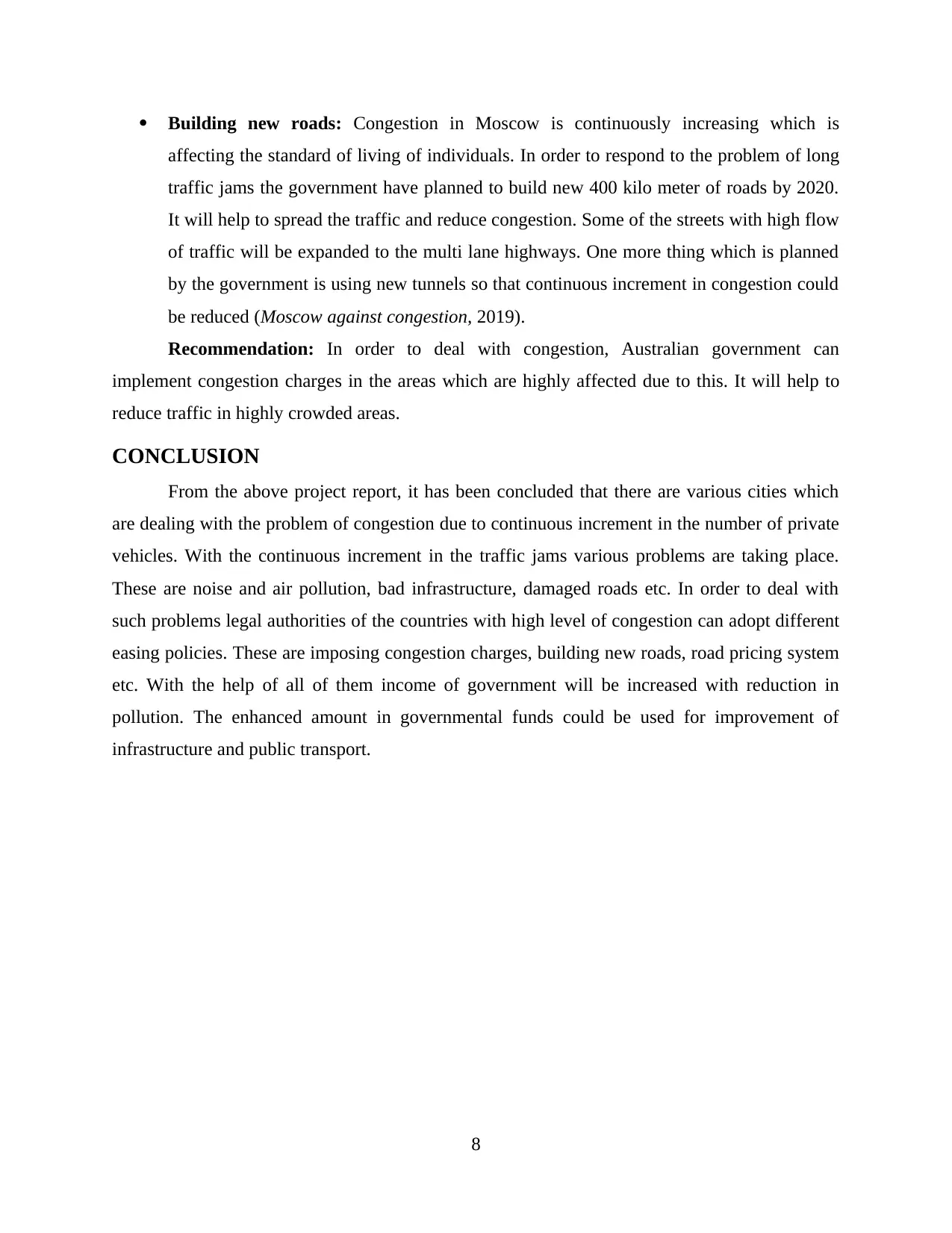
Building new roads: Congestion in Moscow is continuously increasing which is
affecting the standard of living of individuals. In order to respond to the problem of long
traffic jams the government have planned to build new 400 kilo meter of roads by 2020.
It will help to spread the traffic and reduce congestion. Some of the streets with high flow
of traffic will be expanded to the multi lane highways. One more thing which is planned
by the government is using new tunnels so that continuous increment in congestion could
be reduced (Moscow against congestion, 2019).
Recommendation: In order to deal with congestion, Australian government can
implement congestion charges in the areas which are highly affected due to this. It will help to
reduce traffic in highly crowded areas.
CONCLUSION
From the above project report, it has been concluded that there are various cities which
are dealing with the problem of congestion due to continuous increment in the number of private
vehicles. With the continuous increment in the traffic jams various problems are taking place.
These are noise and air pollution, bad infrastructure, damaged roads etc. In order to deal with
such problems legal authorities of the countries with high level of congestion can adopt different
easing policies. These are imposing congestion charges, building new roads, road pricing system
etc. With the help of all of them income of government will be increased with reduction in
pollution. The enhanced amount in governmental funds could be used for improvement of
infrastructure and public transport.
8
affecting the standard of living of individuals. In order to respond to the problem of long
traffic jams the government have planned to build new 400 kilo meter of roads by 2020.
It will help to spread the traffic and reduce congestion. Some of the streets with high flow
of traffic will be expanded to the multi lane highways. One more thing which is planned
by the government is using new tunnels so that continuous increment in congestion could
be reduced (Moscow against congestion, 2019).
Recommendation: In order to deal with congestion, Australian government can
implement congestion charges in the areas which are highly affected due to this. It will help to
reduce traffic in highly crowded areas.
CONCLUSION
From the above project report, it has been concluded that there are various cities which
are dealing with the problem of congestion due to continuous increment in the number of private
vehicles. With the continuous increment in the traffic jams various problems are taking place.
These are noise and air pollution, bad infrastructure, damaged roads etc. In order to deal with
such problems legal authorities of the countries with high level of congestion can adopt different
easing policies. These are imposing congestion charges, building new roads, road pricing system
etc. With the help of all of them income of government will be increased with reduction in
pollution. The enhanced amount in governmental funds could be used for improvement of
infrastructure and public transport.
8
Paraphrase This Document
Need a fresh take? Get an instant paraphrase of this document with our AI Paraphraser
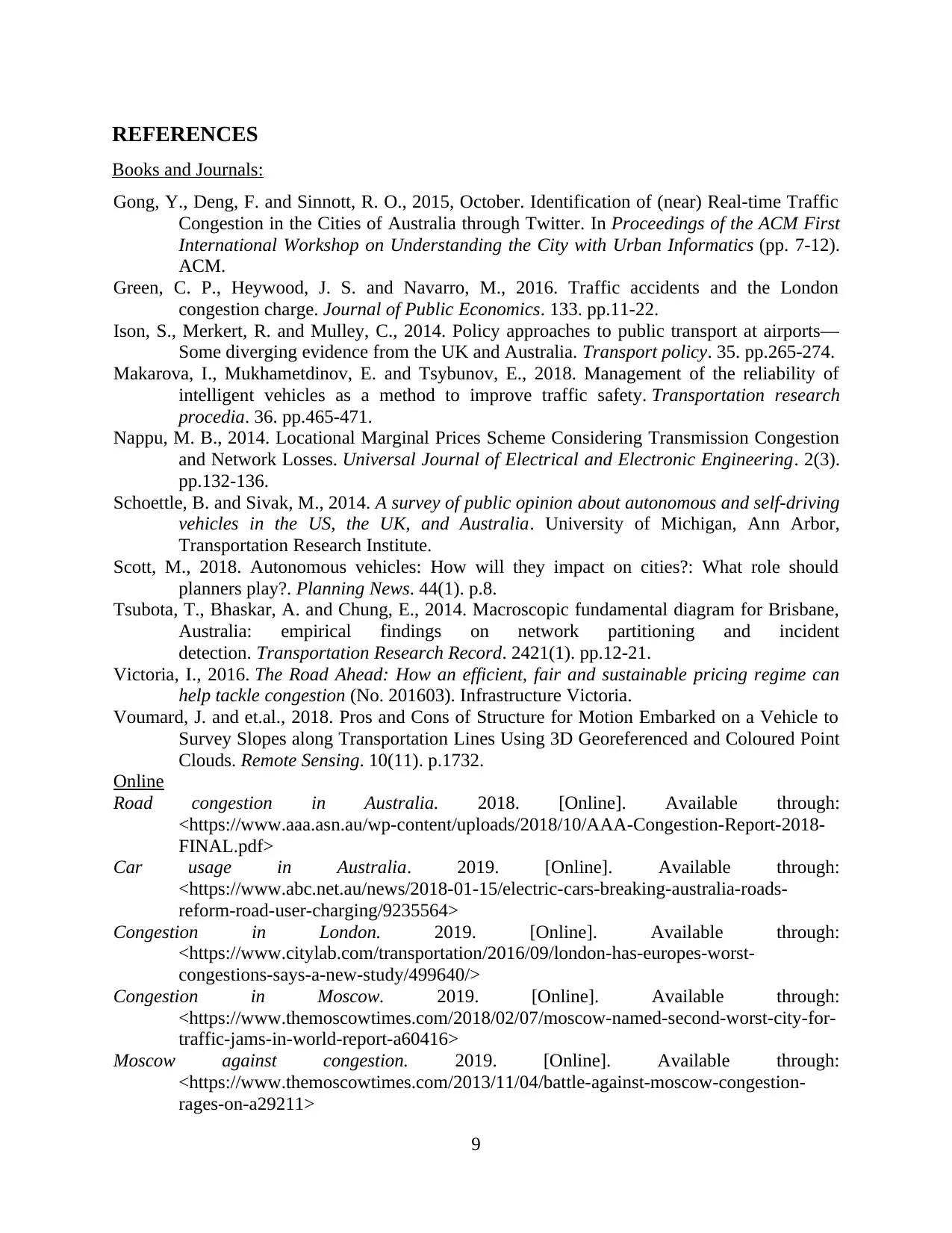
REFERENCES
Books and Journals:
Gong, Y., Deng, F. and Sinnott, R. O., 2015, October. Identification of (near) Real-time Traffic
Congestion in the Cities of Australia through Twitter. In Proceedings of the ACM First
International Workshop on Understanding the City with Urban Informatics (pp. 7-12).
ACM.
Green, C. P., Heywood, J. S. and Navarro, M., 2016. Traffic accidents and the London
congestion charge. Journal of Public Economics. 133. pp.11-22.
Ison, S., Merkert, R. and Mulley, C., 2014. Policy approaches to public transport at airports—
Some diverging evidence from the UK and Australia. Transport policy. 35. pp.265-274.
Makarova, I., Mukhametdinov, E. and Tsybunov, E., 2018. Management of the reliability of
intelligent vehicles as a method to improve traffic safety. Transportation research
procedia. 36. pp.465-471.
Nappu, M. B., 2014. Locational Marginal Prices Scheme Considering Transmission Congestion
and Network Losses. Universal Journal of Electrical and Electronic Engineering. 2(3).
pp.132-136.
Schoettle, B. and Sivak, M., 2014. A survey of public opinion about autonomous and self-driving
vehicles in the US, the UK, and Australia. University of Michigan, Ann Arbor,
Transportation Research Institute.
Scott, M., 2018. Autonomous vehicles: How will they impact on cities?: What role should
planners play?. Planning News. 44(1). p.8.
Tsubota, T., Bhaskar, A. and Chung, E., 2014. Macroscopic fundamental diagram for Brisbane,
Australia: empirical findings on network partitioning and incident
detection. Transportation Research Record. 2421(1). pp.12-21.
Victoria, I., 2016. The Road Ahead: How an efficient, fair and sustainable pricing regime can
help tackle congestion (No. 201603). Infrastructure Victoria.
Voumard, J. and et.al., 2018. Pros and Cons of Structure for Motion Embarked on a Vehicle to
Survey Slopes along Transportation Lines Using 3D Georeferenced and Coloured Point
Clouds. Remote Sensing. 10(11). p.1732.
Online
Road congestion in Australia. 2018. [Online]. Available through:
<https://www.aaa.asn.au/wp-content/uploads/2018/10/AAA-Congestion-Report-2018-
FINAL.pdf>
Car usage in Australia. 2019. [Online]. Available through:
<https://www.abc.net.au/news/2018-01-15/electric-cars-breaking-australia-roads-
reform-road-user-charging/9235564>
Congestion in London. 2019. [Online]. Available through:
<https://www.citylab.com/transportation/2016/09/london-has-europes-worst-
congestions-says-a-new-study/499640/>
Congestion in Moscow. 2019. [Online]. Available through:
<https://www.themoscowtimes.com/2018/02/07/moscow-named-second-worst-city-for-
traffic-jams-in-world-report-a60416>
Moscow against congestion. 2019. [Online]. Available through:
<https://www.themoscowtimes.com/2013/11/04/battle-against-moscow-congestion-
rages-on-a29211>
9
Books and Journals:
Gong, Y., Deng, F. and Sinnott, R. O., 2015, October. Identification of (near) Real-time Traffic
Congestion in the Cities of Australia through Twitter. In Proceedings of the ACM First
International Workshop on Understanding the City with Urban Informatics (pp. 7-12).
ACM.
Green, C. P., Heywood, J. S. and Navarro, M., 2016. Traffic accidents and the London
congestion charge. Journal of Public Economics. 133. pp.11-22.
Ison, S., Merkert, R. and Mulley, C., 2014. Policy approaches to public transport at airports—
Some diverging evidence from the UK and Australia. Transport policy. 35. pp.265-274.
Makarova, I., Mukhametdinov, E. and Tsybunov, E., 2018. Management of the reliability of
intelligent vehicles as a method to improve traffic safety. Transportation research
procedia. 36. pp.465-471.
Nappu, M. B., 2014. Locational Marginal Prices Scheme Considering Transmission Congestion
and Network Losses. Universal Journal of Electrical and Electronic Engineering. 2(3).
pp.132-136.
Schoettle, B. and Sivak, M., 2014. A survey of public opinion about autonomous and self-driving
vehicles in the US, the UK, and Australia. University of Michigan, Ann Arbor,
Transportation Research Institute.
Scott, M., 2018. Autonomous vehicles: How will they impact on cities?: What role should
planners play?. Planning News. 44(1). p.8.
Tsubota, T., Bhaskar, A. and Chung, E., 2014. Macroscopic fundamental diagram for Brisbane,
Australia: empirical findings on network partitioning and incident
detection. Transportation Research Record. 2421(1). pp.12-21.
Victoria, I., 2016. The Road Ahead: How an efficient, fair and sustainable pricing regime can
help tackle congestion (No. 201603). Infrastructure Victoria.
Voumard, J. and et.al., 2018. Pros and Cons of Structure for Motion Embarked on a Vehicle to
Survey Slopes along Transportation Lines Using 3D Georeferenced and Coloured Point
Clouds. Remote Sensing. 10(11). p.1732.
Online
Road congestion in Australia. 2018. [Online]. Available through:
<https://www.aaa.asn.au/wp-content/uploads/2018/10/AAA-Congestion-Report-2018-
FINAL.pdf>
Car usage in Australia. 2019. [Online]. Available through:
<https://www.abc.net.au/news/2018-01-15/electric-cars-breaking-australia-roads-
reform-road-user-charging/9235564>
Congestion in London. 2019. [Online]. Available through:
<https://www.citylab.com/transportation/2016/09/london-has-europes-worst-
congestions-says-a-new-study/499640/>
Congestion in Moscow. 2019. [Online]. Available through:
<https://www.themoscowtimes.com/2018/02/07/moscow-named-second-worst-city-for-
traffic-jams-in-world-report-a60416>
Moscow against congestion. 2019. [Online]. Available through:
<https://www.themoscowtimes.com/2013/11/04/battle-against-moscow-congestion-
rages-on-a29211>
9
1 out of 11
Related Documents
Your All-in-One AI-Powered Toolkit for Academic Success.
+13062052269
info@desklib.com
Available 24*7 on WhatsApp / Email
![[object Object]](/_next/static/media/star-bottom.7253800d.svg)
Unlock your academic potential
Copyright © 2020–2025 A2Z Services. All Rights Reserved. Developed and managed by ZUCOL.





